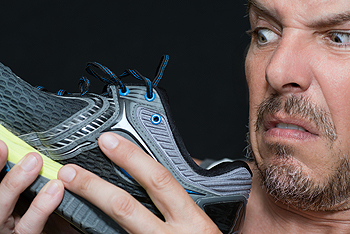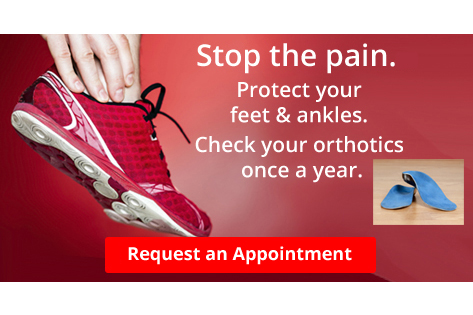Call us directly: (623) 328-8577
18731 N. Reems Road, Suite 640
Surprise, AZ 85374
View Location
Follow us on Facebook ![]()
August 2018
Heel Pain Can Be Treated!
How a Broken Toe Can Affect Your Balance
 If you have ever experienced a broken toe, you are most likely familiar with the pain and discomfort that is associated with it. Despite the small size of the bones the toes are comprised of, they are necessary in maintaining proper balance, while walking and running. There are several symptoms that are indicative of a broken toe, including bruising, swelling, tenderness, and redness. Many people will notice pain that does not dissipate, and may become worse if left untreated. For severely fractured toes, the bone may be displaced and protrude from the area where the break occurred. A proper diagnosis must be obtained, and this can be accomplished by having an X-ray performed and will often be followed by a physical examination. There are several ways to treat a broken toe, and it’s suggested to speak with a podiatrist who can offer correct treatment options.
If you have ever experienced a broken toe, you are most likely familiar with the pain and discomfort that is associated with it. Despite the small size of the bones the toes are comprised of, they are necessary in maintaining proper balance, while walking and running. There are several symptoms that are indicative of a broken toe, including bruising, swelling, tenderness, and redness. Many people will notice pain that does not dissipate, and may become worse if left untreated. For severely fractured toes, the bone may be displaced and protrude from the area where the break occurred. A proper diagnosis must be obtained, and this can be accomplished by having an X-ray performed and will often be followed by a physical examination. There are several ways to treat a broken toe, and it’s suggested to speak with a podiatrist who can offer correct treatment options.
A broken toe can be very painful and lead to complications if not properly fixed. If you have any concerns about your feet, contact Dr. David K. Lee from Arches Foot Institute. Our doctor will treat your foot and ankle needs.
What to Know About a Broken Toe
Although most people try to avoid foot trauma such as banging, stubbing, or dropping heavy objects on their feet, the unfortunate fact is that it is a common occurrence. Given the fact that toes are positioned in front of the feet, they typically sustain the brunt of such trauma. When trauma occurs to a toe, the result can be a painful break (fracture).
Symptoms of a Broken Toe
- Throbbing pain
- Swelling
- Bruising on the skin and toenail
- The inability to move the toe
- Toe appears crooked or disfigured
- Tingling or numbness in the toe
Generally, it is best to stay off of the injured toe with the affected foot elevated.
Severe toe fractures may be treated with a splint, cast, and in some cases, minor surgery. Due to its position and the pressure it endures with daily activity, future complications can occur if the big toe is not properly treated.
If you have any questions please feel free to contact our office located in Surprise, AZ. We offer the newest diagnostic and treatment technologies for all your foot and ankle needs.
Read more about What to Know About a Broken ToeProblems That You May Not Know Your Shoes Are Causing
 Improper shoe fitting can lead to many problems such as bunions, corns, and hammertoe. ill-fitting shoes can also lead to muscular imbalances in the body, which can eventually lead to hip and knee injuries. A perfectly fitting shoe should not have any excess material that may interfere with the foot’s natural motion. Many runners tend to wear shoes that are too small for their feet. If you are looking to purchase a new pair of shoes, be aware of the fact that your foot is at its widest at the toes, even though many shoes are not. You should also be mindful of the fact that your foot will spread up to half an inch in length when you are running. If you are experiencing problems with your feet due to poorly fitting shoes, you may want to schedule an appointment with your podiatrist.
Improper shoe fitting can lead to many problems such as bunions, corns, and hammertoe. ill-fitting shoes can also lead to muscular imbalances in the body, which can eventually lead to hip and knee injuries. A perfectly fitting shoe should not have any excess material that may interfere with the foot’s natural motion. Many runners tend to wear shoes that are too small for their feet. If you are looking to purchase a new pair of shoes, be aware of the fact that your foot is at its widest at the toes, even though many shoes are not. You should also be mindful of the fact that your foot will spread up to half an inch in length when you are running. If you are experiencing problems with your feet due to poorly fitting shoes, you may want to schedule an appointment with your podiatrist.
Finding a properly-fitting shoe is important in reducing injuries and preventing foot problems. For more information about treatment, contact Dr. David K. Lee from Arches Foot Institute. Our doctor will treat your foot and ankle needs.
Proper Shoe Fitting
A common concern when it comes to foot health, having properly fitted shoes can help prevent injuries to the foot. Out feet affect our posture and gait, which in turn affects the biomechanics and overall bodily structure. With 33 joints, 26 bones, and over 100 ligaments, the potential for serious injury is much greater than one realizes. Although the feet cease growth in adulthood, they still change shape as they mature. Here are some factors to consider when it comes to investing in proper fitting shoes:
- Be sure the shoes fit correctly right away
- Ensure the ball of your foot fits comfortably in the widest portion of the shoes
- Even though they may look fashionable, improper fitting shoes can either create adverse conditions or exacerbate existing ones you may already have
- Walk along a carpeted surface to ensure the shoes comfortably fit during normal activity
Keeping in mind how shoes fit the biomechanics of your body, properly-fitting shoes are vitally important. Fortunately, it is not difficult to acquire footwear that fits correctly. Be sure to wear shoes that support the overall structure of your body. Do your feet a favor and invest in several pairs of well-fitted shoes today.
If you have any questions please feel free to contact our office located in Surprise, AZ. We offer the newest diagnostic and treatment technologies for all your foot and ankle needs.
Read more about Proper Shoe FittingReminder: When was the last time...?
Handling Hyperhidrosis
 The human body produces sweat as a reaction to an increase in temperature. Since we are warm-blooded creatures, we excrete water through our pores to avoid overheating. However, it is possible for the body to produce more sweat than what is necessary; this condition is called hyperhidrosis. Hyperhidrosis may be caused by thyroid problems, hormonal fluctuation, anxiety, or medical conditions. One of the tell-tale signs of the condition is that it causes the individual to sweat regardless of the environment they are in. Sweat is meant to be a reactive condition, meaning that it occurs as a result of heat. When people have hyperhidrosis, they produce sweat without regard to the temperature. Additionally, it is common for people with the condition to only sweat in certain areas, such as the feet. If you are dealing with sweaty feet and are looking to find a solution, you should contact your podiatrist right away.
The human body produces sweat as a reaction to an increase in temperature. Since we are warm-blooded creatures, we excrete water through our pores to avoid overheating. However, it is possible for the body to produce more sweat than what is necessary; this condition is called hyperhidrosis. Hyperhidrosis may be caused by thyroid problems, hormonal fluctuation, anxiety, or medical conditions. One of the tell-tale signs of the condition is that it causes the individual to sweat regardless of the environment they are in. Sweat is meant to be a reactive condition, meaning that it occurs as a result of heat. When people have hyperhidrosis, they produce sweat without regard to the temperature. Additionally, it is common for people with the condition to only sweat in certain areas, such as the feet. If you are dealing with sweaty feet and are looking to find a solution, you should contact your podiatrist right away.
If you are suffering from hyperhidrosis contact Dr. David K. Lee of Arches Foot Institute. Our doctor can provide the care you need to attend to all of your foot and ankle needs.
Hyperhidrosis of the Feet
Hyperhidrosis is a rare disorder that can cause people to have excessive sweating of their feet. This can usually occur all on its own without rigorous activity involved. People who suffer from hyperhidrosis may also experience sweaty palms.
Although it is said that sweating is a healthy process meant to cool down the body temperature and to maintain a proper internal temperature, hyperhidrosis may prove to be a huge hindrance on a person’s everyday life.
Plantar hyperhidrosis is considered to be the main form of hyperhidrosis. Secondary hyperhidrosis can refer to sweating that occurs in areas other than the feet or hands and armpits. Often this may be a sign of it being related to another medical condition such as menopause, hyperthyroidism and even Parkinson’s disease.
In order to alleviate this condition, it is important to see your doctor so that they may prescribe the necessary medications so that you can begin to live a normal life again. If this is left untreated, it is said that it will persist throughout an individual’s life.
A last resort approach would be surgery, but it is best to speak with your doctor to find out what may be the best treatment for you.
If you have any questions please feel free to contact our office located in Surprise, AZ. We offer the newest diagnostic and treatment technologies for all your foot and ankle needs.
Read more about Hyperhidrosis of the FeetPossible Causes of Poor Circulation in the Feet
 If you have poor circulation in your feet, it may be indicative of unnoticed health issues. The circulatory system may be negatively affected if you sit for extended periods of time, are obese, or if moderate exercise and stretching is not part of your daily routine. Recent research has shown that a condition, which is referred to as atherosclerosis, may be a common cause of poor circulation in the feet. This may be a result of the arteries becoming narrow, which may lead to blockages in the legs. A common symptom of this ailment may be a loss of feeling in the toes or some patients may experience a tingling sensation. Some preventative measures may include a healthy dietary change added to a routine exercise regime. If you have symptoms of poor circulation in the feet, please consult with a podiatrist for additional information.
If you have poor circulation in your feet, it may be indicative of unnoticed health issues. The circulatory system may be negatively affected if you sit for extended periods of time, are obese, or if moderate exercise and stretching is not part of your daily routine. Recent research has shown that a condition, which is referred to as atherosclerosis, may be a common cause of poor circulation in the feet. This may be a result of the arteries becoming narrow, which may lead to blockages in the legs. A common symptom of this ailment may be a loss of feeling in the toes or some patients may experience a tingling sensation. Some preventative measures may include a healthy dietary change added to a routine exercise regime. If you have symptoms of poor circulation in the feet, please consult with a podiatrist for additional information.
While poor circulation itself isn’t a condition; it is a symptom of another underlying health condition you may have. If you have any concerns with poor circulation in your feet contact Dr. David K. Lee of Arches Foot Institute. Our doctor will treat your foot and ankle needs.
Poor Circulation in the Feet
Peripheral artery disease (PAD) can potentially lead to poor circulation in the lower extremities. PAD is a condition that causes the blood vessels and arteries to narrow. In a linked condition called atherosclerosis, the arteries stiffen up due to a buildup of plaque in the arteries and blood vessels. These two conditions can cause a decrease in the amount of blood that flows to your extremities, therefore resulting in pain.
Symptoms
Some of the most common symptoms of poor circulation are:
- Numbness
- Tingling
- Throbbing or stinging pain in limbs
- Pain
- Muscle Cramps
Treatment for poor circulation often depends on the underlying condition that causes it. Methods for treatment may include insulin for diabetes, special exercise programs, surgery for varicose veins, or compression socks for swollen legs.
As always, see a podiatrist as he or she will assist in finding a regimen that suits you. A podiatrist can also prescribe you any needed medication.
If you have any questions, please feel free to contact our office located in Surprise, AZ. We offer the newest diagnostic and treatment technologies for all your foot care needs.
Read more about Causes Symptoms and Treatment for Poor Circulation in the Feet
(623) 328-8577
Arches Foot Institute
18731 N. Reems Road, Suite 640
Surprise, AZ 85374
© Arches Foot Institute | Cosmetic Foot Surgery | David Lee, DPM
Surprise Podiatrist | Surprise Podiatry | Surprise Foot Doctor



